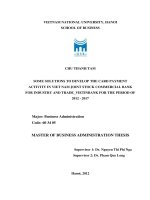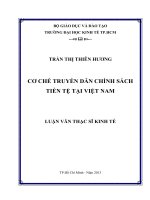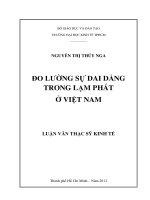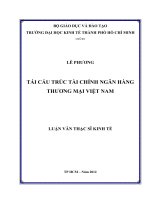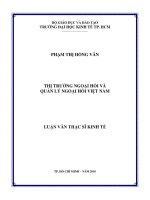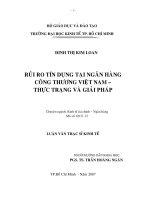(Luận văn thạc sĩ) some solution to develop the card payment activity in viet nam joint stock comercial bank for industry and trade vietinbank for the period of 2012 2017
Bạn đang xem bản rút gọn của tài liệu. Xem và tải ngay bản đầy đủ của tài liệu tại đây (1.48 MB, 122 trang )
VIETNAM NATIONAL UNIVERSITY, HANOI
SCHOOL OF BUSINESS
CHU THANH TAM
SOME SOLUTIONS TO DEVELOP THE CARD PAYMENT
ACTIVITY IN VIET NAM JOINT STOCK COMMERCIAL BANK
FOR INDUSTRY AND TRADE_VIETINBANK FOR THE PERIOD OF
2012 - 2017
Major: Business Administration
Code: 60 34 05
MASTER OF BUSINESS ADMINISTRATION THESIS
Supervisor 1: Dr. Nguyen Thi Phi Nga
Supervisor 2: Dr. Pham Quy Long
Hanoi, 2012
COMMITMENT
I would like to commit that all the content of this thesis is not submitted to
any training programs or Universities
I am also committed to add that this thesis is my personal effort. All the
analysis and conclusions in this dissertation ( Not include quotations) are the
results of my personal works
Hanoi, February 10 , 2012
Signature of student
-----------------------------------Chử Thanh Tâm
i
ABSTRACT
SOME SOLUTIONS TO DEVELOP THE CARD PAYMENT
ACTIVITY IN VIETNAM JOINT STOCK COMMERCIAL BANK
FOR INDUSTRY AND TRADE FOR THE PERIOD OF 2012 - 2017
Chu Thanh Tam
MBA Candidate, 2008 – 2010
Vietnam National University, Hanoi School of Business
Supervisor: Dr. Nguyen Thi Phi Nga and Dr. Pham Quy Long
February 2012, 111 pages.
Vietnam Joint Stock Commercial Bank for Industry and Trade is one of the
four largest banks in Viet Nam. VietinBank has emerged as the most effective
and profitable bank in Vietnam banking sector, with the goal of becoming the
number one financial group in Vietnam and has positioned in Asia within 3 to
5 years, one of present strategies to achieve above objectives, VietinBank
determined that developing retail banking services as important part
constitutes strategy. In which, develop card account product, payment card,
especially card payment service is considered the core product in the context
of extremxe active card market in Vietnam today.
VietinBank entry the card market relatively late, before 2008 VietinBank
products and services card had not located the great value to people in
compare with card’s brand of others bank. Since 2009, Vietinbank officially
reached its spectacular from low class market share to become the absolute
leader in market share for the number of cards issue and POSs. However, the
card quality, in detail card payment turnover or revenue on cards not worth
the potential of VietinBank, not worth the current leading market share in
quantity now.
ii
In card payment services market, Although VietinBank has ranked second in
market share, the distance is not really far from the adjacent bank and still
keep the far distance from the leading bank in this field_ VietcomBank. With
the big current potential and advantage, VietinBank can fully become the
leading bank for service segment in general and card payment services in
particular when developing a appropriate strategy.
To support VietinBank in building solutions, the thesis will analyze
opportunities and challenges from the market, at the same time clarify and
analyze the strengths and weaknesses from the VietinBank, from which to set
out some measures to improve efficiency of VietinBank card payment
business.
These measures are feasible, close to the reality of VietinBank, if applied they
will actually support VietinBank further improve competitiveness, promote
strength, resolve weaknesses. From which completely shorten the gap with
the leading banks and compellingly striving to leader in short time.
iii
TÓM TẮT
MỘT SỐ GIẢI PHÁP NHẰM NÂNG CAO HIỆU QUẢ HOẠT
ĐỘNG KINH DOANH THANH TỐN THẺ TẠI NGÂN
HÀNG TMCP CƠNG THƯƠNG VIỆT NAM 2012 – 2017
Chử Thanh Tâm
Học viên MBA, 2008 – 2010
Đại học Quốc Gia Hà Nội, Khoa Quản Trị Kinh Doanh
Hướng dẫn: Tiến sĩ Nguyễn Thị Phi Nga và Tiến sĩ Phạm Quý Long
Tháng 2 năm 2012, 111 trang
Ngân hàng TMCP Công Thương Việt Nam (VietinBank) là một trong 4 ngân
hàng lớn nhất Việt Nam. VietinBank hiện đang nổi lên như một ngân hàng
hoạt động hiệu quả và lợi nhuận lớn nhất trong ngàng Ngân hàng Việt Nam,
với mục tiêu trở thành tập đồn tài chính số một Việt Nam và có vị thế Châu
Á trong vịng 3 đến 5 năm tới, hiện nay trong các chiến lược đề ra nhằm đạt
mục tiêu trên VietinBank xác định phát triển dịch vụ Ngân hàng bán lẻ là một
bộ phận chiến lược cấu thành quan trọng. Trong đó là phát triển các sản phẩm
tài khoản, thẻ thanh toán và đặc biệt là dịch vụ thanh toán thẻ được coi là sản
phẩm cốt lõi trong bối cảnh một thị trường Thẻ ở Việt Nam đang rất năng
động như hiện nay.
VietinBank gia nhập thị trường thẻ khá muộn, và cho đến trước năm 2008 sản
phẩm dịch vụ thẻ của VietinBank còn chưa định vị được giá trị lớn với người
dân so với các thương hiệu thẻ của các Ngân hàng khác. Song chính thức kể
từ năm 2009 Vietinbank đã vươn mình ngoạn mục từ vị trí thị phần số lượng
thẻ nằm chiếu dưới và đến nay đứng đầu tuyệt đối về thị phần số lượng thẻ/
máy thanh toán thẻ phát hành. Tuy nhiên về chất lượng thẻ, mà cụ thể là
iv
doanh số thanh toán thẻ, nguồn thu được trên thẻ hiện tại vẫn chưa xứng đáng
với tiềm năng cuả VietinBank với thị phần về số lượng số một hiện nay.
Trên thị trường thanh toán thẻ, mặc dù vươn lên vị trí thứ hai về thị phần dịch
vụ thanh tốn thẻ nhưng khoảng cách không thực sự xa so với ngân hàng liền
kề và cách rất xa so với ngân hàng dẫn đầu VietcomBank. Với tiềm năng và
lợi thế rất lớn hiện tại, VietinBank hồn tồn có thể trở thành ngân hàng dẫn
đầu về mảng dịch vụ nói chung, dịch vụ thanh tốn thẻ nói riêng khi xây dựng
cho minh một chiến lược đúng đắn phù hợp.
Đề hỗ trợ việc xây dựng chiến lược cho VietinBank, luân văn sẽ phân tích các
cơ hội thách thức đến từ thị trường, đồng thời phân tích làm rõ các điểm mạnh,
điểm yếu từ phía VietinBank để từ đó đề ra một số biện pháp nhằm nâng cao
hiệu quả hoạt động kinh doanh thanh toán thẻ VietinBank
Đây là những biện pháp có tính khả thi cao, sát với thực tế của Ngân hàng
TMCP Công Thương Việt Nam nếu được áp dụng sẽ thực sự hỗ trợ
VietinBank nâng cao hơn nữa năng lực cạnh tranh, phát huy thế mạnh, giải
quyết các điểm yếu để từ đó hoàn toàn rút ngắn khoảng cách với Ngân hàng
dẫn đầu về mảng này và vươn lên dẫu đầu một cách thuyết phục tuyệt đối.
v
TABLE OF CONTENTS
COMMITMENT .......................................................................................................... i
ABSTRACT ................................................................................................................ ii
TÓM TẮT .................................................................................................................. iv
TABLE OF CONTENTS ........................................................................................... vi
LIST OF TABLE ....................................................................................................... ix
LIST OF ABBRIVIATIONS ..................................................................................... xi
INTRODUCTION .......................................................................................................1
CHAPTER 1: THE BASIC ISSUES ON THE CARD PAYMENT ACTIVITY .....4
1.1 OVERVIEW OF THE BANK CARD AND REAL SITUATION OF THE
CARD PAYMENT .....................................................................................................4
1.1.1 Definition of the bank card and card payment ...................................................4
1.1.2 Classification of bank card and form of card payment ......................................5
1.1.3 The of formation and development history of the payment card in Vietnam ....7
1.2 PROCESS OF THE CARD PAYMENT ............................................................12
1.2.1 Overall process of card payment ......................................................................12
1.2.2 The participation entities of the card payment .................................................13
1.2.3 Charges and charges sharing rate in the card payment activity .......................14
1.3 THE ROLES AND THE MEANINGS OF CARD PAYMENT ACTIVITY ....15
1.3.1 For the society- national economy. ..................................................................15
1.3.2 For the bank joining in the payment ................................................................18
1.3.3 Impact on the card owner and the unit accepting the card payment ................22
vi
CHAPTER 2: THE FACTUAL SITUATION OF CARD PAYMENT IN
VIETINBANK ..........................................................................................................26
2.1 GENERAL INTRODUCTION ON VIETINBANK ..........................................26
2.1.1 The general introduction on VietinBank ..........................................................26
2.1.2 The general introduction on VietinBank Card business Center .......................27
2.1.3 The process of formation and development of payment operation by card at
VietinBank. ...............................................................................................................30
2.2 THE POSITION OF VIETINBANK CARD SERIVES ....................................32
2.2.1 The prominent speed of growth, leading in the quantity of market share. ......32
2.2.2 The quality and profit have not yet been proportional to the potential ............37
2.3 THE FACTUAL SITUATION OF IMPLEMENTATION AND
DEVELOPMENT OF PAYMENT SERVICE BY CARD IN VIETINBANK .......41
2.3.1 The factual situation of implementation and development of card business and
payment .....................................................................................................................41
2.3.2 The evaluation of real situation of conducting and developing the
VietinBank’s card payment. ......................................................................................54
2.4 SWOT ANALYSIS ON VIETINBANK CARD PAYMENT BUSINESS ........59
2.4.1 External environment analysis- challenges and opportunities of VietinBank. 60
2.4.2 Internal environment analysis- strong and weak point. ..................................68
2.4.3. SWOT matrix analysis ....................................................................................75
CHAPTER 3: SOME SOLUTIONS TO DEVELOP CARD PAYMENT
ACTIVITY IN VIETINBANK .................................................................................80
3.1 Focusing on the market segment, groups of lines and types of card which bring
the sales of payment and profit. ................................................................................80
vii
3.1.1 Exploiting the group of lines bringing the sales of payment and high profit. .80
3.1.2. Increase the transaction according to the card forms and the transaction forms
...................................................................................................................................81
3. 2. Cover and scoop the whole open and potential market ....................................83
3.3 Improve the card payment business effectiveness through marketing mix 7Ps .85
3.3.1. P1 - Product: ....................................................................................................85
3.3.2 The price ...........................................................................................................92
3. 3.3 Promotion and media ......................................................................................95
3.3. 4 Place - Distribution channels .........................................................................97
3. 3.5 Human resource ..............................................................................................99
3. 3.6 The process ................................................................................................... 100
3. 3.7 The physical evidence .................................................................................. 102
3.4. SOME RECOMMENDATION ...................................................................... 104
3.4.1 The recommendation to the government on the policy and legal lobby ....... 104
3.4.2 The recommendation to some relevant merchants, boards, sections. ........... 105
REFERENCES ....................................................................................................... 106
Appendix 1
Apenndix 2
Appendix 3
viii
LIST OF TABLE
Table 2.1 : The results of Card payment implementation and development ............42
Table 2.2 : Popupar Objetion on POS sales ..............................................................44
Table 2.3 : Parameters of the training conduct .........................................................47
Table 2.4: Some basic financial indicators ...............................................................54
Table 2. 5&6: estimation calculation of some finacial indicators on two leading
banks..........................................................................................................................57
Table 2.7: Takcare quality comparison table ............................................................73
Table 3.1 : VietinBank revenue by region and category...........................................80
Table 3.2: Revenue by credit card type .....................................................................82
Table 3.3: MOTO transaction and the normal transaction comparison ....................90
Table 3.4: EDC quantity and card payment revenue. ...............................................98
ix
LIST OF FIGURES
Figure 1.1 : General payment-via-card process ........................................................12
Figure 1.2: The roles of the card payment activity ...................................................15
Figure 1.3: Benefits for payment bank ......................................................................19
Figure 1.4: Credit Card statement cycles ..................................................................21
Figure 2.1 : Debitcard segmentation in 2010 ............................................................33
Figure 2.2 : Credit card segmentation in 2010 ..........................................................34
Figure 2.3 : POS segmentation in 2010 ....................................................................37
Figure 2.4 : Card payment revenue in 2010 ..............................................................39
Figure 2.5 : Card payment sales of two Banks .........................................................40
Figure 2.6 : The model of implementation and development of card business and
payment .....................................................................................................................41
Figure 2.7: The POS sales channel in 2010 ..............................................................48
Figure 2.8 : Micro-environment analysis of business ...............................................60
Figure 2.9: Michael Porter’s five forces model ........................................................65
Figure 2.10 : Michael Porter’s Value chain model ...................................................71
Figure 3.1: The reason for changing card payment sales ..........................................83
Figure 3.2: The awareness of promotion programs ..................................................96
Figure 3.3: Information flow .....................................................................................96
x
LIST OF ABBRIVIATIONS
EMV
Euro Master Visa
IRR
Internal Rate of Return
NPV
Net Present Value
POS
Point of sales
EDC
Electronic Data Capture
VTB
VietinBank
xi
INTRODUCTION
1.1Reasons for the subject’s selection
Vietnam Joint Stock Commercial Bank for Industry and Trade_ VietinBank
has been identifying that the retail bank’s service development is an important
part in its development strategy, and especially, of which developing the
account product, the payment card, the payment service by card is considered
as the core and basic products in the context that the Card market in Vietnam
is being evaluated the most dynamic market all over the world, with the
growth rate of 18,4% annually from 2014, the tendency of card payment is the
tendency of the near future. With the aim of becoming the number one
financial group of Vietnam and having the position in Asia, one of the large
targets of VietinBank is developing the card payment as the leader. In front of
the above situation and as the staff working in Card business Center Department of Marketing and Sales under Headquarter of VietinBank, I
decided to choose the subject “Some solutions to develop the card payment
activity in Vietnam Joint Stock Commercial Bank for Industry and
Trade_VietinBank for the period of 2012-2017”.
1.2 .The objective of the research
The research objective is to systemize theoretical framework related to the
business services of the bank card payment. Then analysing the real situation
and the card payment business of VietinBank, since then recommending the
practical and applied solutions to increase the profits from the card payment
activity of VietinBank matching with the potential, to shorten the gap with the
first competitor and toward to occupy the market and become the leading
bank of Vietnam and have the position in the local area.
1.3. Scope of the study
1
Becoming the number one retail bank in domestic in the service sector
requires the research and analysis in many subject, many different fields of
the experienced and deeply understanding persons in the financial sector in
general and the retail financial sector in particular, since then building the
synchronous and practical strategy with the reality of this bank.
Due to the limited time and working conditions, the study scope of the subject
is limited with researching some solutions to develop the card payment
activity in Vietnam Joint Stock Commercial Bank for Industry and TradeVietinBank. In detail, the reseach study the card payment service business in
VietinBank at 152 its branches and Card Business Center as primary data and
also collect secondary data about others banks such as Vietcombank,
Agribank, Techcombank, HSBC, AnZ bank ….during the study time from
2009 to 2011
The study entities are mainly 3 characters who are Merchants – Shops or
supper markets use card payment method according to cash payment method,
Customer – card owner and VietinBank staffs – people undertake VietinBank
card payment serivce business.
1.4. Research method:
Some methods of analysis, evaluation, comparison and collection are used to
study and build the thesis, of which the analysis method (micro, macro
environments method, SWOT matrix analysis) will be mainly used. For the
theoretical base of the subject, the thesis uses the research, the writings on the
card payment activity in general and the card payment activity in Vietnam
market in particular conducted by the leading experts. The used theoretical
bases include the theoretical bases on payment card, card payment activity,
factors impacting on the card payment turnover, the specific strategy of the
banking service, etc combining with real survey in the card payment
2
merchants of the research bank and the competitive bank, referring the
successful models of the foreign countries.
1.5. New contribution of the subject
The subject uses the real and the most updated data from the reports of
Vietnam Card Association, the Department of Market Research, Department
of Sales of Card business center; as well as uses the primary data from the
real survey in card acceptance merchants of the banks, survey in the card
owners, the bank’s staffs working in the department of card payment service.
Therefore, the subject will contribute the solutions matching with the reality
and the present situation of VietinBank, these solutions are specific in
contents, creativeness, and feasible to apply for VietinBank in term of
becoming the leading bank of card payment service in Vietnam. At the same
time, the subject will be useful to recommend the solutions for developing the
card payment service for any specific unit trading the card payment service in
Vietnam market.
1.6. Structure of the subject
The thesis is structured with 3 chapters and 1 section, in details as follows;
- Introduction
- Chapter 1: The basic issues on the card payment activity
- Chapter 2: The real situation of the card payment development in
VietinBank company
- Chapter 3: Some solutions to develop the card payment activity on
VietinBank.
3
CHAPTER 1: THE BASIC ISSUES ON THE CARD
PAYMENT ACTIVITY
1.1 OVERVIEW OF THE BANK CARD AND REAL SITUATION OF
THE CARD PAYMENT
1.1.1 Definition of the bank card and card payment
The ancestor of the payment card is the purchase card when the shops sale the
purchase cards for the customers to buy the goods instead of cash. In 1949,
Frank Mc Namara, an American businessman, invented the first payment card
named “Dinner’s Club”. This card was useful to pay the restaurant invoices,
the card owners could eat in the restaurant without paying in cash. This was
the paper card, used in the system of Dinners Club. Then in 1958, American
Express Organization issued the first charge card, Bank of American also
issued the bank card which was called VISA card at the same year. In 1966,
MasterCard was appeared, it was considered as the competitor of VISA card.
Therefore, it can be defined that the card payment is the payment method in
which the card owner can use the card to pay for the goods and services
purchase money or withdraw automatically cash through the card readers or
the automated taller machines, or in other words, the card payment is payment
method without using the cash but the card.
The material of the first payment card was paper, but its disadvantage was
easy to corrupt and tear, so it was gradually replace by the plastic card with
the better endurance. When the demands of information security and large
storage became the considered issue, the card with the magnetic tape and the
intelligent card using the EMV standard as a very small computer was
appeared and helped to perform the banking operations such as license
permission and bank clearing. The payment card is developed diversified such
4
as card classification, the payment card linking with many non-financial
function cards become the connection cards or co-trademark cards. The forms
of using card are very flexible, sometimes; the payment does need the direct
appearance of the card but can be un-touch payment by the payment machine.
1.1.2 Classification of bank card and form of card payment
1.1.2.1 According to the payment characteristic of the card
According to the payment characteristic of the card, there are two main forms:
Credit card and Debit card
Credit card: is the card allowing the card owners to implement payment,
withdrawing within the issued credit line according to the agreement with the
card issuance bank. This is the most popular used bank, the card owners are
entitled to use the credit line without being paid the interest to purchase the
goods and the services in the business merchants, hotels, airport, etc which
accept this card. It was called the credit card because the card owners can
advance the consumption line without being paid money immediately, only
paid after the certain period. From this characteristic, the credit card can be
called the delayed debit card or deferred debit card.
Debit card: is the card allowing the card owners to implement payment,
withdrawing within the amount of money in the payment deposit account of
the card owners opened in a bank. This is the card which has the direct
relation and connects with the deposit account. When this card is used to buy
the goods or the services, the transaction values will be immediately deducted
into the owner’s account by the electronic devices located at the shops, the
hotels, etc; at the same time, immediately transfer to the account of the shops,
the hotels. The debit card is also used to withdraw cash in the automated taller
machine. The debit card does not have the credit line because it is based on
the available balance in the account of the card owners.
5
Besides the above two cards, there is Cash card: this is the cash drawing card
in the automated taller machine or the bank. With the specific function only
using for cash drawing, to use this card is that the card owners have to deposit
into the bank account or the card owners have to be issued the credit in
account.
1.1.2.2 According to payment scope
According to the payment scope, the card can be used in Vietnam and can be
used worldwide.
Domestic card: is the card which is limited in the scope of a nation, so that
the exchange currency must be the local currency of this country. The home
debit card and the home credit card are the domestic cards.
International card: is the card which is accepted all over the world, uses the
strong foreign exchange for payment. The international debit card and the
international credit card are the international cards and can be used for
payment both in the foreign countries.
1.1.2.3 According to issuance entity
Bank Card: is the card issued by the bank in order to help the clients use
amount of money financed by the Bank. This card is mainly used in Vietnam.
Non-bank Card: is the tourism and entertainment cards issued by the large
business groups or the big petrol companies, the large shops, etc such as
Dinner’s Club, Amex, etc.
1.1.2.4 According to production technology
Embossing card: Based on the embossing technology; the first card was
produced by this technology. At the present, this card is not been used no
longer because its technology is too simple, easy for counterfeit.
Magnetic stripe: Based on the letter technique with two magnetic tapes
storing information in the card’s back. This card was used popular in the last
6
20 years, but there are some weaknesses: because the information in the card
can not be coded by itself, the card only stores the fixed information, the data
storage space is litter; it can not apply the coding technique, information
security, etc.
Smart Card: this is the newest generation of the payment card; the structure
of the card is the same as a computer.
1.1.3 The of formation and development history of the payment card in
Vietnam
1.1.3.1 History of formation and appearance of the payment card in
Vietnam
In 1990, VietcomBank signed the contract of Visa card disbursement agency
with French bank, this activity started the adoption of the payment card into
Vietnam. The main purpose of this connection was to serve for the
international tourists coming to Vietnam. Following the Foreign Trade Bank,
Sai Gon Thuong Tin Bank also connected with the center of Visa card
payment for becoming the payment agency. May be the clear open policy
brought for Vietnam a socio-economic face with many potentials. The foreign
investment projects have increased from the quantity to the scope, the large
financial institutions have paid attention to Vietnam and following these
groups, there are the concurrent services of which the payment card is integral.
In 1995, Ho Chi Minh City Foreign Bank, A Chau Commercial Joint Stock
Bank, First-Vina-Bank and Eximbank were allowed to officially join in the
Mastercard international card organization by Governor of the State Bank of
Vietnam.
In 1996, the Foreign Bank officially became the member of Visa International
Organization. Then, A Chau Bank, VietinBank Vietnam also became the
official members of the Visa Card Organization, of which the Foreign Bank
7
and A Chau Bank implemented the direct payment with this organization. At
this year, Vietnam Foreign Bank (VCB) issued pilot the first bank card, as
well as the association of Vietnam card payment banks was also established
with the four founders including VietcomBank, A Chau Commercial Joint
Stock Bank, Joint Stock Commercial Bank for Import and Export (Eximbank)
and First Vinabank. The legal corridor for the card activity at that time was
only the Decision No. 74 issued by Governor of the State Bank on 10/4/1993
regulating the “temporary regulations on issuing and using the payment card”.
The card application in Vietnam at that time was limited by the legal base,
economic and technical structure conditions, etc. Based on the agreement of
the State Bank, the commercial bank pilot issuing the card had to set up the
rules, the issuance contract and the card utilization by itself, it means that the
legality was only in the rate of “internal” adjustment between the issuance
bank and the owners. It can be said that VietinBank joined in this playground
later than VietcomBank near half of the decade; the knowledge and the
experience about the card of VietcomBank are the clear advantages and the
competitive advantages of this leading bank.
The card market in 2006, 2007 was eventful because Vietnam joined in the
large playground- WTO, Vietnam financial market competed fiercer when
there were many more the foreign banks investing on this sector and the credit
card service and ATM card were the efficient “weapons” for the bank to
penetrate the market. A series of payment card products were appeared,
opened a “card issuance competition” among the domestic banks.
1.1.3.2 The development of payment card in Vietnam and some
achievements
In over the last 15 years, the card service has been developed with the high
speed, from when being considered as a property or a trademark of the
8
successful person, at the present, the bank card becomes the popular payment
tool. According to the State Bank, the card service has had the high growth
rate in the recent years, 150-300%/year. By the end of 2007, the banks issued
near 8,3 million of cards, in average among 10 persons, there is one person
using the card. According to the statistic, the card market of Vietnam in 2007
grew 2,5 times in comparison with 2006. By the end of 2007, a number of the
card issued by the banks are near 8,3 million of cards, in comparison with 3,5
million of cards in 2006. At the present, the payment density by card accounts
for 6% in the sum of the exchanges of non-cash payment tools. Among the
cards issued by the domestic issuance organizations, the local debit card
(popular named ATM card) accounts for 93,87%, then the international debit
card accounts for 3,65%, the international credit card accounts for 2,22% and
the local credit card accounts for 0,31%. Despite the unevenly density, it can
show that the card service has created the important channel leading the
capitals for the banks, because most of the issued card quantities are
connected with the individual deposit account and there are a certain deposit
balance in this. In Vietnam, there are 32 banks issuing the card, with about
130 different card trademarks, of which 54% are the local card trademarks.
By the end of 2007, there were 4.300 ATM machines in all the country; over
23.000 places accepted the payment by POS card. In comparison with 2006,
the above number was 2.500 ATM and 14.000 POS. At the present, the main
card unions in Vietnam include Smartlink Company with 25 members, 2.056
ATM machines (accounting for 48%), 17.502 POS/EDC machines
(accounting for 57%) and the number of issued cards of 4.721.946 (57%);
East Asia Card Union with 05 members, issuing 1.766.053 cards (21%), 783
ATM machines (18%), and 1.682 POS/EDC machines (57%); International
Financial Switching Joint Stock Company Banknetvn with the number of
9
ATM machines accounting for 62% (2.654 machines), POS/EDC accounting
for 46% (10.548) and issuing 5.170.229 cards (accounting for 62%).
In 2007, in the tendency of increasing the competitiveness, many banks issued
the card forms with the high security, which was the CHIP card with the
EMV standard and supplying many attached benefits for the customers such
as payment for the goods and services’ invoice, online purchase, account
overdraft, preferential enjoyment on service and purchase rebate in the
connection place, payment insurance amount by card, savings remittance by
card besides the basic benefits such as cash drawing, transferring.
By the end of 2010, the growth rate of the card market was very great; there
were 15.000 ATM machines in all country, over 40.000 places accepting the
payment by POS card. The two large unions, Banknet and Smartlink
cooperated with each other and gathered the card payment for all the member
banks.
1.1.3.3 Some main obstacles in the progress of the card payment
development activity
Although there are the above significant achievements, Vietnam payment card
has many limits and insufficiencies preventing the development progress of
the payment card, in details:
The biggest obstacle which makes the card quantities low in comparison with
the market potential is that the habit of using the cash in consumption of
Vietnamese people is very popular. According to the statistic of Visa
International Organization, the cash supply in the circulation in the developed
countries is only 10-25% whereas in the developing countries this number is
75-90%. In particular, in Vietnam, according to Head Representative of Visa
Gordon Cooper, the cash is still the “king” over 99% of individual
consumption is performed by this form. For the current ATM system in
10
Vietnam, most of the exchanges are for cash drawing, although there are
many other utilities such as credit transfer, payment for insurance service,
electricity, telephone fees, etc.
Many countries all over the world, pioneering in ATM sector, underwent 03
development stages; firstly each bank set up the individual payment system
by itself. Then the bank groups which committed to use the same system
would be formed. Lastly, all the banks would cooperate to set up the unique
system. The Chief Ta Quang Tien said that “Vietnam is the behind country,
we can study to skip the second stage, by actually we are swept away by the
old method of the pioneer countries”. “The main reason is that Vietnam lacks
an instruction and management mechanism, does not have the clue
organization to mobilize and collect whereas the banks are not consensus;
even they consider the ATM development as the competitive weapon”.
The security issue of card payment is not been assured, leading to the disorder
and unbelief of the card users. At the present, using the fake card to draw
money from the customer’s account is often occurred, even the robbery in the
ATM machine, using the devices to destroy ATM machine. The above
situation is partly caused by the weak payment network management, low
card production technology. At the present, in the world, the chip cards are
mostly used while the magnetic cards are mainly used in Vietnam. As we
know, the security of the chip card is higher than the magnetic cards.
11
1.2 PROCESS OF THE CARD PAYMENT
1.2.1 Overall process of card payment
Figure 1.1 : General payment-via-card process
(Sources: Card centre - VietinBank )
Step 1: The card owner submits the request of card issuance and receives the
card printed by the issuance bank, owns the account with his/her name,
deposits into the card if this is the debit card.
Step 2-3: Sell the goods in the business merchants which accepts the card
payment. Implement the payment for the amounts in the purchase invoices by
swiping the card performed by cashier or the owner.
Step 4: If the money is enough to pay, and the card swiping exchange is
successful, the payment amounts paid by the bank will be reported credit in
the account of the shop’s owner.
Step 5: The payment bank will charge the card payment by reporting the card
payment debt into the account of the shop’s owner.
Step 6: The payment band and the issuance bank through the card union
organization will make the offset accounting, reporting the debt for the
advanced amounts of the shop’s owner to the issuance bank so that the
12
issuance bank can report and account to deduct in the account of the card
owner, each party will retrieve the receivable charges.
1.2.2 The participation entities of the card payment
The card owner: is the person whose name is written in the card and is
entitled to use the card to pay the amounts of goods and service purchase.
Only the card owner can use his/her card. When paying for the Merchants of
the goods, services or paying the debts, the card owner has to show the card in
order to check under the process and set up the payment receipt.
Merchants: are the goods and services business sectors which sign with the
payment bank on accepting the card payment such as the restaurants, the
hotels, the shops, etc. These merchants have to equip the machines,
technology to receive the payment card for the goods and services amounts,
the debt payment replacing for cash. This entity plays the roles of issuing the
cards and remaining the account.
Issuance bank: is the bank which issues the card for the owner. This bank is
usually the official member of the international card organizations. The
issuance bank takes responsibility to receive the document of the card
issuance request, solve and issue the card, open and control the card’s account,
as well as implement the last payment with the owner. This entity plays the
role of developing and maintaining the relations with the Merchants.
Payment bank: is the bank which installs the card payment machines. The
bank directly signs the contract with the receipt unit and pays the exchange
documents presented by the Merchants. A bank can play the role of card
payment and the role of issuance.
International card organization and switching card organization: are the
organizations which connect the payment bank and the issuance bank. This
entity takes responsibility to switch and solve the clearing payment, set up the
13

